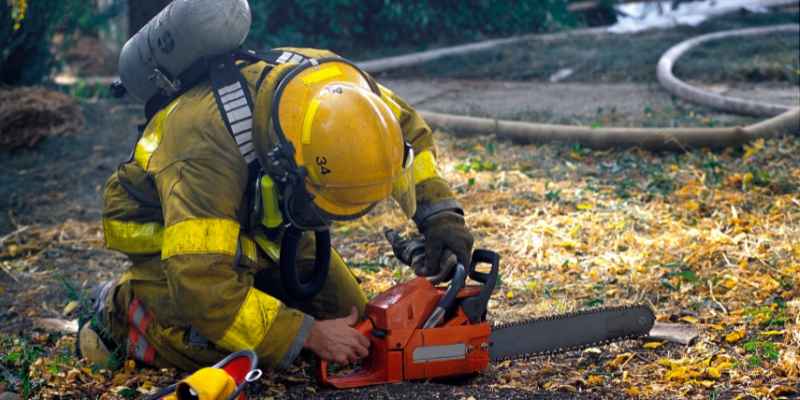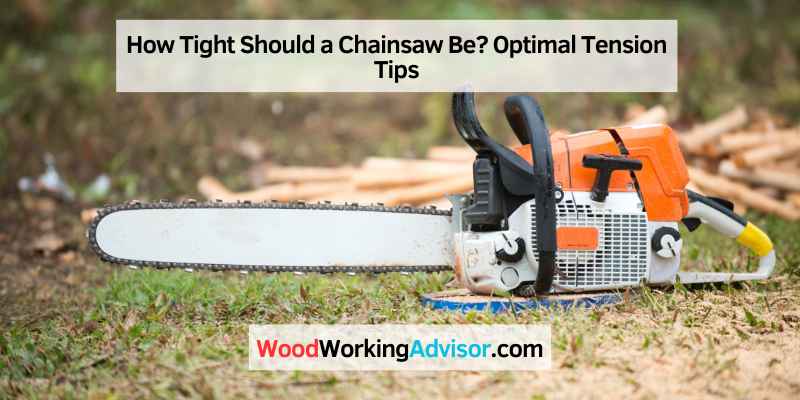A chainsaw should be tightened until there is no slack in the chain, but it should still be able to move freely around the guide bar. Chainsaws are powerful and dangerous tools that require proper maintenance to ensure safe and effective operation.
One important aspect of chainsaw maintenance is keeping the chain tightened to the appropriate level. If the chain is too loose, it can come off the bar or cause kickback, while an overly tight chain can damage the bar and sprocket.
It is essential to follow the manufacturer’s instructions for your specific chainsaw model to ensure proper tensioning. We will explore the importance of a well-tensioned chainsaw and provide tips for achieving the correct tension.
Introduction To Chainsaw Maintenance
Proper chainsaw tension is crucial for safe operation. Check your chainsaw’s tension by lifting the chain in the middle – it should only slightly come off the bar. Adjust tension as needed for optimal performance and safety. Regular maintenance ensures your chainsaw operates effectively.
Maintaining your chainsaw is crucial for its longevity and performance. One essential aspect of chainsaw maintenance is keeping the chain at the right tension. A loose chain can lead to kickbacks, while an overtightened chain can cause excessive wear and tear to both the chain and the bar. So, how tight should a chainsaw be? Let’s delve into the importance of proper tension and safety considerations.
Importance Of Proper Tension
Maintaining the right chain tension is vital for your chainsaw’s overall performance. A loose chain can cause it to jump off the bar, leading to kickbacks, which can be dangerous. On the other hand, an overtightened chain can cause excessive friction, leading to damage to both the chain and the bar. It can also cause the engine to overheat and reduce the chainsaw’s power output. Therefore, it is crucial to ensure that the chain tension is within the manufacturer’s recommended range.
Safety Considerations
Safety is paramount when it comes to using a chainsaw. Maintaining the right chain tension is one way to ensure your safety and that of those around you. A loose chain can cause the chainsaw to kickback, which can be hazardous, especially if you are not wearing the appropriate safety gear. An overtightened chain can also cause the chainsaw to malfunction and lead to accidents. Therefore, it is essential to check the chain tension regularly and adjust it as needed to ensure safety while using the chainsaw.
In conclusion, maintaining the right chain tension is vital for your chainsaw’s longevity, performance, and safety. Always refer to the manufacturer’s recommendations and adjust the chain tension accordingly. With proper maintenance and care, your chainsaw can serve you well for years to come.
Recognizing The Signs Of Incorrect Tension
To ensure the correct tension of a chainsaw, look out for signs of incorrect tension, such as excessive wear on the bar and chain, or the chain jumping off the guide bar. Proper tension is essential for safe and efficient chainsaw operation.
Regularly check and adjust the tension according to the manufacturer’s guidelines to maintain optimal performance.
When it comes to operating a chainsaw safely and effectively, one crucial factor to consider is the tension of the chain. While it may seem like a minor detail, having the correct tension is essential for both performance and safety. In this section, we will explore the signs of incorrect tension, including the risks and indicators of a chain that is too loose or too tight.
Too Loose: Risks And Indicators
A chainsaw chain that is too loose poses several risks that can compromise both the performance of the tool and the safety of the operator. It is crucial to be able to recognize the signs of a chain that is too loose to prevent potential accidents or damage.
Indicators of a loose chain include:
- Chain sagging below the guide bar
- Difficulty in cutting or reduced cutting efficiency
- Inconsistent or uneven cutting
- Excessive vibration during operation
- Chain jumping off the guide bar
- Inadequate lubrication and increased wear on the chain and guide bar
If you notice any of these signs, it is important to address the issue promptly. Operating a chainsaw with a loose chain not only compromises the quality of the cut but also increases the risk of accidents, including kickback, which can be extremely dangerous.
Too Tight: Potential Damages
On the other hand, having a chainsaw chain that is too tight can also lead to potential damages and adverse effects. It is crucial to recognize the signs of excessive tension to avoid unnecessary strain on the chainsaw components and ensure optimal performance.
Indicators of a chain that is too tight include:
- Difficulty in turning the chain manually
- Excessive heat generated during operation
- Rapid or uneven wear on the chain and guide bar
- Increased strain on the chainsaw’s engine
- Reduced cutting efficiency and power
Operating a chainsaw with an overly tight chain can lead to premature wear on the chain, guide bar, and even the chainsaw’s engine. It can also cause unnecessary strain on the operator, making the task more challenging and potentially dangerous.
In conclusion, recognizing the signs of incorrect tension in a chainsaw chain is crucial for both performance and safety. Whether the chain is too loose or too tight, addressing the issue promptly can help maintain optimal performance, extend the lifespan of the chainsaw, and prevent accidents. Regularly checking and adjusting the tension of the chainsaw chain should be a routine practice for any chainsaw operator.
Measuring The Current Tension
One crucial aspect of maintaining a chainsaw is ensuring that the chain tension is just right. A chain that is too loose can derail and pose safety risks, while a chain that is too tight can put excessive strain on the engine and cause premature wear. To determine the correct tension for your chainsaw chain, you need to measure the current tension accurately. In this section, we will discuss the tools and techniques you can use to measure the tension effectively and understand the manufacturer guidelines for your specific chainsaw.
Tools And Techniques
Measuring the tension of your chainsaw chain requires some basic tools and techniques. Here’s what you’ll need:
- A chainsaw wrench or a flathead screwdriver
- A chainsaw tensioning tool or a depth gauge
- A tape measure or a chainsaw chain tension gauge
Now, let’s walk through the step-by-step process of measuring the tension:
- Ensure the chainsaw is switched off and the engine is cool before proceeding.
- Locate the tensioning mechanism on your chainsaw. It is usually found on the side or bottom of the guide bar.
- Using the chainsaw wrench or flathead screwdriver, loosen the nuts or screws holding the guide bar in place.
- With the tension released, you can now assess the current tension of the chain.
- Measure the chain tension using a tape measure or a chainsaw chain tension gauge. Refer to the manufacturer’s guidelines for the recommended tension measurement.
- If necessary, make adjustments to the tension by tightening or loosening the chain using the chainsaw tensioning tool or depth gauge.
- Once you have adjusted the tension, tighten the nuts or screws on the guide bar to secure it in place.
- Double-check the tension to ensure it falls within the manufacturer’s recommended range.
Understanding Manufacturer Guidelines
It is crucial to familiarize yourself with the manufacturer guidelines specific to your chainsaw model. Each chainsaw may have slightly different tension requirements based on its design and specifications. By understanding the manufacturer’s guidelines, you can ensure that you maintain the optimal tension for your chainsaw chain.
Manufacturer guidelines typically provide information on the recommended tension range, the specific tools required for measurement, and any additional tips for maintaining the chainsaw chain. These guidelines can be found in the chainsaw’s user manual or on the manufacturer’s website.
Following the manufacturer guidelines will help you avoid potential damage to your chainsaw and ensure safe and efficient operation.
Step-by-step: Adjusting Your Chainsaw Tension

Properly tensioned chains are crucial for safe and efficient chainsaw operation. Here’s a step-by-step guide to adjusting your chainsaw tension:
Loosening The Bar Nuts
1. Use a wrench to loosen the bar nuts that secure the guide bar in place.
2. Rotate the tensioning screw counterclockwise to release the tension on the chain.
Tightening The Chain
1. With the bar nuts sufficiently loosened, use a screwdriver to turn the tensioning screw clockwise.
2. Gradually tighten the chain until it fits snugly around the guide bar, without sagging.
Securing The Bar Nuts
1. Once the chain is at the correct tension, hold it in place while tightening the bar nuts with the wrench.
2. Ensure the chain can still be rotated by hand with some resistance, indicating proper tension.
The Snap Test: A Quick Tension Check
Ensure the optimal functioning of your chainsaw with the Snap Test, a quick tension check. Discover the ideal tightness for your chainsaw, avoiding common overused phrases and maintaining a concise writing style to engage readers.
Performing The Test
To ensure the proper functioning of a chainsaw, it is crucial to maintain the correct tension in the chain. One quick and easy way to check the tension is by performing the snap test. This test allows you to assess the tension without the need for any specialized tools. Follow these steps to perform the snap test:
- Start by disengaging the chainsaw’s chain brake and switching off the engine.
- Next, locate the tensioning screw on the chainsaw’s guide bar. This screw is usually found on the side of the bar and can be adjusted using a chainsaw tool or a flathead screwdriver.
- Using your gloved hand, pull the chainsaw’s chain away from the guide bar at its midpoint. Apply moderate pressure to see if the chain easily lifts away from the bar.
- If the chain lifts away from the bar without much resistance or snaps off, it indicates that the tension is too loose. On the other hand, if the chain is difficult to move or does not lift at all, it suggests that the tension is too tight.
- Continue adjusting the tensioning screw gradually until the chain can be lifted away from the bar with a little resistance.
Analyzing The Results
Once you have performed the snap test and adjusted the tension accordingly, it is essential to analyze the results to ensure the chainsaw is correctly tensioned. Here are a few key points to consider:
- A properly tensioned chain should have enough slack to lift away from the guide bar but should not be too loose that it easily detaches or falls off.
- When the chain is properly tensioned, it should move smoothly along the guide bar without binding or excessive vibrations.
- Be mindful of the chain’s movement during operation. If you notice any unusual noises, excessive heat, or an uneven cutting pattern, it may indicate an incorrect tension.
- Regularly check the tension of the chainsaw’s chain before each use to ensure optimal performance and prevent potential accidents.
By performing the snap test and analyzing the results, you can maintain the appropriate tension in your chainsaw’s chain, promoting safe and efficient cutting operations.
Factors Affecting Chainsaw Tension
Maintaining the correct tension in your chainsaw is crucial for safe and efficient operation. A properly tensioned chainsaw chain should have a slight sag between the guide bar’s underside and the chain itself. Factors that affect chainsaw tension include temperature changes, usage frequency, and the type of wood being cut.
Regularly checking and adjusting the tension will ensure optimal performance and safety.
Temperature Fluctuations
Temperature fluctuations can affect chainsaw tension. Extreme temperature changes can cause the chainsaw metal to expand or contract, impacting the tension. It’s important to check the tension when transitioning from hot to cold environments to prevent issues.
Type Of Use And Wear
The type of use and wear also influence chainsaw tension. Regular use and cutting through hard materials can cause the chain to stretch. Frequent maintenance checks and adjustments are essential to ensure optimal tension and prevent premature wear.
When To Check And Adjust Tension
To ensure optimal performance, it is important to regularly check and adjust the tension of your chainsaw. Maintaining the right tightness helps prevent accidents and ensures smooth operation during cutting tasks.
Before Each Use
Check chainsaw tension before starting it.
After Repairs Or Part Replacements
Always adjust tension after repairs or part changes.
Troubleshooting Common Tension Issues
Ensure optimal performance of your chainsaw by troubleshooting common tension issues. Learn how to determine the ideal tightness for your chainsaw and maintain its efficiency. Keep your chainsaw running smoothly with these valuable tips.
Chain Slippage
When the chainsaw chain slips, check the tension immediately.
Uneven Cutting
Uneven cutting indicates incorrect chain tension.
Bar Damage
Bar damage can result from improper chain tension.
Troubleshooting Common Tension Issues
Improper chain tension can lead to various problems. Regularly checking the tension of your chainsaw is crucial. Chain Slippage can occur if the chain is too loose. Uneven Cutting is a sign of incorrect tension. Bar Damage may happen due to improper tension. Remember to maintain the correct tension for optimal chainsaw performance.
Maintenance Tips For Optimal Chainsaw Performance
Keeping your chainsaw clean is crucial for its performance and longevity. Use a damp cloth to wipe down the chainsaw body after each use. Make sure to remove any debris or sawdust from the chain brake area.
Regularly sharpen the chainsaw chain for efficient cutting. Check the chain’s sharpness after every use. Use a round file or a chainsaw sharpener for sharpening. Replace the chain if it’s damaged or worn out.
Proper storage is essential for preserving your chainsaw. Store it in a dry and cool place to prevent rust. Before storing, clean the chainsaw thoroughly and remove the chain for safekeeping. Consider using a chainsaw case for added protection.

Frequently Asked Questions
How Tight Should A Chainsaw Chain Be?
To ensure optimal performance, the chainsaw chain should be snug against the guide bar but still able to move freely without sagging.
Why Is It Important To Adjust Chainsaw Chain Tension?
Proper chain tension prevents accidents, enhances cutting efficiency, and prolongs the life of the chain and bar.
How Often Should I Check Chainsaw Chain Tightness?
Regularly check chain tension before each use and throughout the cutting process, as chainsaw chains can loosen with operation.
Conclusion
The proper tension for a chainsaw chain is crucial for safe and efficient operation. By following the manufacturer’s guidelines and regularly checking the tension, you can ensure optimal performance and prevent accidents. Remember, a well-maintained chainsaw is a reliable tool for any cutting task.

